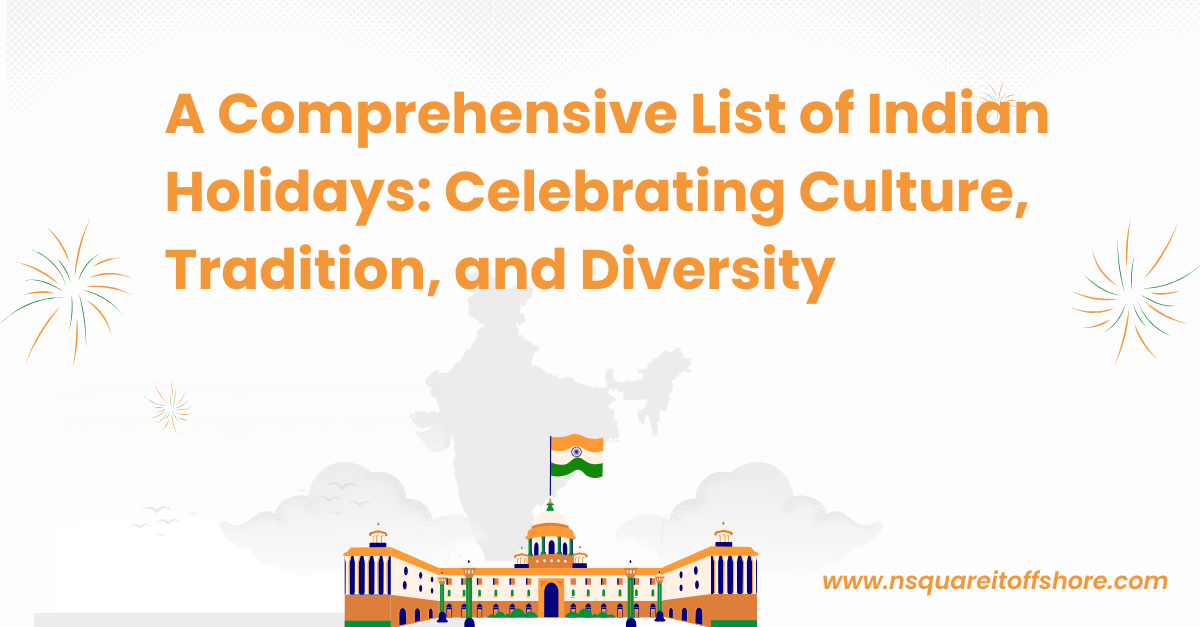A Comprehensive List of Indian Holidays: Celebrating Culture, Tradition, and Diversity
February 25th, 2025

India, with its rich history, diverse cultures, and vibrant traditions, celebrates a wide variety of holidays throughout the year. These holidays are celebrated by different communities, regions, and religions, making India’s holiday calendar one of the most colorful and unique in the world. While some holidays are observed nationwide, others are specific to certain states or communities.
In this blog, we’ll take you through a comprehensive list of Indian holidays and explain what makes each one special.
1. New Year’s Day (January 1)
While New Year’s Day is celebrated worldwide, in India, it marks the start of the Gregorian calendar year. This day is celebrated with joy and enthusiasm across the country, though different regions also observe their own new year festivals based on local calendars, such as Gudi Padwa and Vishu.
2. Republic Day (January 26)
Republic Day commemorates the adoption of the Constitution of India in 1950, making India a republic. Celebrated with grandeur, especially in New Delhi, Republic Day features a grand parade at Rajpath showcasing India’s military power and cultural diversity. The flag-hoisting ceremonies and cultural events across the country make it a day of national pride.
3. Maha Shivaratri (February/March)
Maha Shivaratri, meaning “Great Night of Shiva,” is a major Hindu festival dedicated to Lord Shiva. Observed by fasting, night vigils, and prayers, this day is celebrated with immense devotion, particularly in places like Varanasi and Somnath, known for their iconic temples dedicated to Shiva.
4. Holi (March)
Known as the festival of colors, Holi marks the arrival of spring and the victory of good over evil. People celebrate by playing with colored powders, dancing, singing, and feasting. Though celebrated across India, it’s particularly prominent in northern India, with cities like Mathura, Vrindavan, and Jaipur hosting grand celebrations.
5. Good Friday (March/April)
Good Friday is a significant Christian holiday commemorating the crucifixion of Jesus Christ. Christians across India observe this day with church services, fasting, and prayer. The holiday is especially observed in Goa, Kerala, and the northeastern states where Christianity has a deep-rooted history.
6. Independence Day (August 15)
Independence Day celebrates India’s freedom from British rule in 1947. It is marked by flag-hoisting ceremonies, cultural events, and patriotic displays throughout the country. The Prime Minister addresses the nation from Red Fort in New Delhi, while similar events take place in schools, offices, and public spaces.
7. Ganesh Chaturthi (August/September)
Ganesh Chaturthi is one of the most popular Hindu festivals dedicated to Lord Ganesha, the remover of obstacles. The festival is famous for its vibrant celebrations, especially in Maharashtra, where elaborate processions and huge Ganesha idols are paraded through the streets before being immersed in water.
8. Dussehra (September/October)
Dussehra, also known as Vijayadashami, celebrates Lord Rama’s victory over the demon king Ravana. It is marked by performances of Ramlila (a dramatic retelling of the Ramayana) and the burning of effigies of Ravana. This festival is celebrated with much zeal across northern and western India, especially in Uttar Pradesh and Rajasthan.
9. Diwali (October/November)
Diwali, the Festival of Lights, is one of the most widely celebrated holidays in India. It signifies the triumph of light over darkness and good over evil. The festival is marked by lighting oil lamps, bursting fireworks, exchanging sweets, and visiting family and friends. Diwali is celebrated by people of different faiths across the country, with spectacular events in cities like Mumbai, Varanasi, and Kolkata.
10. Eid al-Fitr (Date Varies)
Eid al-Fitr marks the end of Ramadan, the holy month of fasting in Islam. After a month of fasting and prayer, Muslims celebrate with prayers at mosques, feasts, and family gatherings. It’s a public holiday in India, observed with great enthusiasm in regions with large Muslim populations, such as Hyderabad, Kashmir, and Uttar Pradesh.
11. Christmas (December 25)
Christmas, celebrating the birth of Jesus Christ, is widely observed by Christians across India. Families attend church services, sing carols, share festive meals, and exchange gifts. Christmas is particularly celebrated in Goa, Kerala, and the northeastern states, where Christian communities are larger.
12. Gudi Padwa (March/April)
Gudi Padwa marks the Marathi New Year and is celebrated with much enthusiasm in Maharashtra and Goa. On this day, a decorated Gudi (a flag on a pole) is hoisted outside homes, symbolizing prosperity. The festival involves wearing new clothes, visiting family members, and preparing traditional sweets like Puran Poli.
13. Baisakhi (April)
Baisakhi is celebrated as a harvest festival in Punjab and Haryana. It is also significant for Sikhs as it commemorates the formation of the Khalsa in 1699. The day is celebrated with vibrant Bhangra and Gidda dances, along with prayers at gurudwaras (Sikh temples).
14. Raksha Bandhan (August)
Raksha Bandhan celebrates the bond between brothers and sisters. Sisters tie a sacred thread (rakhi) around their brothers’ wrists, symbolizing protection, while brothers give gifts in return. This festival is widely celebrated across India, bringing families closer together.
15. Navratri (September/October)
Navratri, a nine-night festival dedicated to worshipping Durga, is celebrated with great fervor across India. During the festival, people observe fasting, conduct prayers, and participate in Garba and Dandiya dances, especially in Gujarat and Maharashtra. The festival ends with Dussehra, symbolizing the triumph of good over evil.
Conclusion
India’s holiday calendar is a beautiful reflection of its diversity and rich cultural heritage. From the vibrant colors of Holi to the majestic lights of Diwali, these holidays bring people together to celebrate life, love, and tradition. Whether you’re observing these holidays with family or experiencing them for the first time, these celebrations offer a unique insight into India’s fascinating cultural fabric.
By understanding and participating in these celebrations, you get a chance to experience the essence of India, a land where unity in diversity is a way of life.